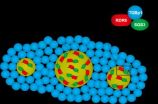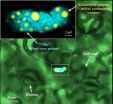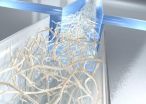(Press-News.org) University of Tokyo researchers have described how a plant-virus protein suppresses an important plant defense mechanism that remembers viral genetic information, providing a new target for developing the first-ever chemical against plant viruses that globally cause more than $60 billion of crop losses each year.
Invading viruses carry genetic material that hijacks the host cell's machinery, fooling it into producing proteins and new viruses. All cells from fungi to plants and mammals employ RNA silencing, a cellular process essential for the regulation of gene expression that also functions as an important defense mechanism. Through RNA silencing, plant cells recognize this viral genetic material, remember and copy it so that other cells in the organism can be warned and destroy the virus. Viruses are known to fight back with RNA silencing suppressors, proteins that inhibit this defense mechanism, but how they interfere with the recording of viral genetic information was unknown. Now, a research team headed by Professor Shigetou Namba and Dr. Yukari Okano in the Graduate School of Agricultural and Life Sciences has shown for the first time that the plant virus protein TGBp1 disarms RNA silencing by causing two enzymes involved in producing copies of viral genetic information to aggregate as inactive clusters in cells surrounded by the virus protein.
The two enzymes are SGS3 and RDR6, which are involved in producing copies of viral genetic information as double-stranded RNA, an essential step in the plant defense process. The researchers demonstrated that TGBp1 interacted with and inhibited the functions of SGS3 and RDR6, and attached fluorescent markers to TGBp1 and SGS3 to show visually that SGS3, which is usually distributed throughout the cell, formed clusters surrounded by TGBp1. These results suggest that TGBp1 causes the enzymes SGS3 and RDR6 to form clusters, impeding the formation of double-stranded RNA and inhibiting the recording of viral genetic information, thus reducing plant resistance to viral infection.
"We expected that recording viral genetic information would be the most important step in RNA silencing, because if you can't remember the virus, you can't warn the rest of the organism and stop it spreading," explains Professor Namba. "This would also make it important for the virus to target, but no one had confirmed any viral RNA silencing suppressors targeting this step in plants. Now we are very excited to be the first to do so, and we expect that other plant viral proteins will be found to have similar functions. Recently other researchers have reported that some viruses infecting humans also have RNA silencing suppressors, so this research may also contribute to the development of medicines targeting those viruses."
INFORMATION:
Keywords: RNA silencing, RNA silencing suppressor, double-stranded RNA, plant virus, TGBp1, SGS3, RDR6, plantago asiatica mosaic virus
Article information
Yukari Okano, Hiroko Senshu, Masayoshi Hashimoto, Yutaro Neriya, Osamu Netsu, Nami Minato, Tetsuya Yoshida, Kensaku Maejima, Kenro Oshima, Ken Komatsu, Yasuyuki Yamaji and Shigetou Namba, "In planta recognition of a dsRNA synthesis protein complex by a potexviral RNA silencing suppressor" The Plant Cell 26 (5) May 2014.
doi: 10.1105/tpc.113.120535
http://www.plantcell.org/content/early/2014/05/30/tpc.113.120535.abstract
Links
The University of Tokyo
http://www.u-tokyo.ac.jp/en/
Graduate School of Agricultural and Life Sciences
http://www.a.u-tokyo.ac.jp/english/
Laboratory of Plant Pathology
http://papilio.ab.a.u-tokyo.ac.jp/planpath/en/index-en.html
Contact information
Research contact:
Professor Shigetou Namba
Laboratory of Plant Pathology
Graduate School of Agricultural and Life Sciences
The University of Tokyo
1-1-1 Yayoi, Bunkyo-ku, Tokyo 113-8657
Tel: +81 (0)3-5841-5053
Fax: +81 (0)3-5841-5054
Email: anamba@mail.ecc.u-tokyo.ac.jp
Press officer:
Yoko Takemoto
Public Relations Division
The University of Tokyo
7-3-1 Hongo, Bunkyo-ku, Tokyo 113-8654
Tel: +81 (0)3-5841-2031
Fax: +81 (0)3-3816-3913
Email: kouhoukikaku@ml.adm.u-tokyo.ac.jp
Virus rounds up enzymes, disarms plant
2014-06-02
ELSE PRESS RELEASES FROM THIS DATE:
New Population Council research presented at 13th ESC Annual Congress
2014-06-02
LISBON, PORTUGAL (31 May 2014) – This week, the Population Council presented new research at the 13th Congress of the European Society of Contraception and Reproductive Health. Presentations included a pharmacokinetic analysis of the Council's investigational one-year contraceptive vaginal ring containing Nestorone® and ethinyl estradiol, and its investigational male contraceptive implant MENT®, as well as new approaches to "green contraception," including strategies to ensure that future contraceptive technologies are both effective and protect the environment.
"The ...
Clinical trial shows drug combination may be effective in recurrent ovarian cancer
2014-06-02
VIDEO:
Dr. Joyce Liu talks about her clinical trial showing drug combination may be effective in recurrent ovarian cancer.
Click here for more information.
CHICAGO –– Significant improvement with the use of a combination drug therapy for recurrent ovarian cancer was reported at the annual meeting of the American Society of Clinical Oncology (ASCO) meeting in Chicago today. This is the first ovarian cancer study to use a combination of drugs that could be taken orally. The ...
New data shows ProMark accurately predicts aggressive prostate cancer, pathology outcomes
2014-06-02
CAMBRIDGE, Massachusetts, June 2, 2014 – Today, for the first time, Metamark presents results from the clinical validation study that showed ProMark™, the first and only proteomic-based imaging biopsy test, achieved its primary endpoint by accurately differentiating between aggressive and non-aggressive forms of prostate cancer at early stages of disease. ProMark™ was shown to predict which patients have low-risk disease with a sensitivity of 90 percent or better, confidently identifying patients who are appropriate for active surveillance or need aggressive therapy. The ...
Study shows tale of 2 prognoses in pediatric brain tumor, pilocytic astrocytoma
2014-06-02
Pilocytic astrocytoma (PA) is a primarily pediatric brain tumor caused mainly by mutations in the BRAF gene. In fact, there are two specific mechanisms for activation of BRAF implicated in PA formation: by fusion of the gene with nearby gene KIAA1549 (K:B fusion) or by point mutations of the BRAF gene itself. Research presented at the American Society for Clinical Oncology (ASCO) Annual Meeting 2014 used a newly designed test for K:B fusion to show that point mutations lead to a more dangerous form of the disease than does K:B fusion.
"Overall, the prognosis for Pilocytic ...
DREAM project crowdsources answer to cancer cell drug sensitivities
2014-06-02
A study published June 1 in the journal Nature Biotechnology describes the results of an open challenge to predict which breast cancer cell lines will respond to which drugs, based only on the sum of cells' genomic data. The winning entry, from the Helsinki Institute for Information Technology, was 78 percent accurate in identifying sensitive versus resistant cell lines, and was one of 44 algorithms submitted by groups from around the world.
"The idea is simple – we have this question and anybody can participate in searching for the answer. The question is, do we have ...
A master of disguise: A new stick insect species from China
2014-06-02
Many representatives of the fauna possess unique masking abilities but stick insects are among the masters of disguise within the animal world. During a field trip in Guangxi, China Mr. Ho Wai-chun George from the Hong Kong Entomological Society discovers a new species from this enigmatic insect group, which he describes in a recent research paper published in the open access journal Deutsche Entomologische Zeitschrift.
Like the name suggests the new stick insect Sinophasma damingshanensis is distinguished by peculiarly elongated body and green-brownish coloration, which ...
New species from the past
2014-06-02
A piece of Eocene Baltic Amber of about 45 million years age contains a well preserved extinct flat bug, which turned out to be a new species to science. This exciting discovery is one of the many secrets that deposits of Baltic amber have revealed in the last years and are yet to come in the future. The study describing the new species was published in the open access journal Deutsche Entomologische Zeitschrift.
The new species Aradus macrosomus is a rather large representative of the genus, differing by its size and particular structures from its congeners. The name ...
Same face, many first impressions
2014-06-02
Slight variations in how an individual face is viewed can lead people to develop significantly different first impressions of that individual, according to research published in Psychological Science, a journal of the Association for Psychological Science.
"Our findings suggest that impressions from still photos of individuals could be deeply misleading," says psychological scientist and study author Alexander Todorov of Princeton University.
Previous research has shown that people form first impressions about someone's personality after viewing their face only briefly. ...
What finding out a child's sex before birth says about a mother
2014-06-02
COLUMBUS, Ohio – An expectant mother who chooses to find out her child's sex before birth may be giving subtle clues about her views on proper gender roles, new research suggests.
The study found that women who choose not to learn their child's sex may be more open to new experiences, and combine egalitarian views about the roles of men and women in society with conscientiousness.
On the other hand, expectant mothers who scored high on a test of parenting perfectionism were more likely than others to learn their baby's sex.
"These results suggest women who choose ...
Stronger than steel
2014-06-02
A Swedish-German research team has successfully tested a new method for the production of ultra-strong cellulose fibres at DESY's research light source PETRA III. The novel procedure spins extremely tough filaments from tiny cellulose fibrils by aligning them all in parallel during the production process. The new method is reported in the scientific journal Nature Communications.
"Our filaments are stronger than both aluminium and steel per weight," emphasizes lead author Prof. Fredrik Lundell from the Wallenberg Wood Science Center at the Royal Swedish Institute of Technology ...






